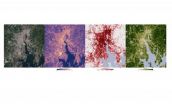(Press-News.org) WEST LAFAYETTE, Ind. - Face-to-face workplace interactions may be the best way to educate and encourage people to consider becoming organ donors, according to new research from Purdue University.
"Workplaces are a key location for people to learn about health and wellness issues, but how information is distributed in this setting can make a difference for sensitive health topics such as organ donation," said Susan E. Morgan, a professor of communication. "There is an incredible amount of misinformation and medical mistrust surrounding the organ donation process, which is often fueled by inaccurate story lines in entertainment media. Common misperceptions include that favoritism is shown for potential recipients and people who register to be donors will receive lower-quality care.
"We found that people who had a chance to discuss the topic and their misgivings with others were more likely to sign up compared to those who just read about organ donation in a brochure distributed at their workplace."
The findings are published in this issue of Communication Monographs.
Morgan and her research team coordinated campaigns for organ donation through the New Jersey Workplace Partnership for Life project at 45 businesses that ranged from 100-3,200 employees. The 10-week campaigns either consisted of a more traditional low-intensity approach, which is common in most work settings, a high-intensity approach or a control group.
In the low-intensity campaign, employees only received information from sources such as in internal newsletters, brochures or phone messages left on their voicemail systems. The high-intensity approach utilized low-intensity strategies along with on-site visits from organ procurement staff. A control group also was observed, and 9,477 employees completed pre-and/or post-campaign surveys related to their beliefs on organ donation.
"The interpersonal interactions also were valuable because the staff was able to address people's misgivings or any confusion about the process, and the on-site visits create a bit of a spectacle because they also set up a display that included an organ donor quilt and other items that helped spark conversation," Morgan said. "Deep down, many people feel that signing up to be an organ donor is a noble thing to do, but they have these fears and they feel silly sharing those. This setting provides a more comfortable place to ask questions. When a person sees a co-worker sign up to be an organ donor it often makes them feel better about approaching the topic. This is the principle of social proof in action."
Both campaigns led to an increase in people signing up as organ donors, but an average of 11 percent of the employees at the high-intensity sites who were not already registered organ donors completed and returned their registry forms. The low-intensity campaign led to a 3-percent increase. These are 13.6 percent and 6.8 percent increases, respectively, over the control group.
"The interpersonal component led to a change, that if applied universally, could amount to approximately 11 percent of the eligible workforce signing up to be an organ donor," Morgan said. "Increases of this size potentially equate to hundreds of lives saved through donation, which translates into millions of dollars saved in health-care costs for the chronically ill people who will receive transplants."
Many of the 108,000 people who need organs are often suffering from complications related to common chronic illnesses such as diabetes, hypertension and heart disease. It is estimated that nearly 7,000 people die each year because an organ was not available. According to Donate Life America, 35 percent of Americans have signed up with an organ donor registry to ensure that after they die, their organs and tissue can help someone else.
Morgan and colleagues also will be evaluating worksite characteristics, such as location of breakrooms or spaces for posters, to determine the effectiveness of worksite health campaigns.
###
The article's co-authors are Tyler R. Harrison, associate professor of communication at Purdue; Lisa Chewning, an assistant professor of communication at Pennsylvania State University; Mark. J. DiCorcia, assistant chair of medical education at Indiana School of Medicine; and LaShara A. Davis, a doctoral candidate at Purdue.
The study was supported by a grant from the Health Resources and Services Administration's Division of Transplantation at the U.S. Department of Health and Human Services.
Related websites:
Susan Morgan:
http://cla.purdue.edu/communication/People/index.cfm?p=Susan_Morgan
Donate Life America:
http://www.donatelife.net/
Abstract on the research in this release is available at: http://www.purdue.edu/newsroom/research/2010/101213MorganOrgan.html
END
A one-year follow-up study on seniors who participated in a strength training exercise program shows sustained cognitive benefits as well as savings for the healthcare system. The research, conducted at the Centre for Hip Health and Mobility at Vancouver Coastal Health and the University of British Columbia, is published today in the Archives of Internal Medicine.
The study is the first to examine whether both cognitive and economic benefits are sustained after formal cessation of a tailored exercise program. It builds on the Brain Power Study, published in the January ...
Results from a government-sponsored clinical trial of inactivated 2009 H1N1 influenza vaccine in people with asthma indicate that a single dose of vaccine was safe and induced a strong immune response predictive of protection. The findings also suggest that individuals over the age of 60 who have severe asthma may require a larger dose of vaccine.
The study was cosponsored by the National Institute of Allergy and Infectious Diseases (NIAID) and the National Heart, Lung, and Blood Institute (NHLBI), two components of the National Institutes of Health, and appears online ...
WEST LAFAYETTE, Ind. - Changes in diet have been linked to a reduction of abnormal behaviors in mentally ill people or animals, but a Purdue University study shows that diet might also trigger the onset of mental illness in the first place.
Joseph Garner, an associate professor of animal sciences, fed mice a diet high in sugar and tryptophan that was expected to reduce abnormal hair-pulling. Instead, mice that were already ill worsened their hair-pulling behaviors or started a new self-injurious scratching behavior, and the seemingly healthy mice developed the same abnormal ...
CHAMPAIGN, Ill. – The Obama administration's decision to maintain a ban on oil drilling in the eastern Gulf of Mexico and off the Atlantic and Pacific coasts is a mistake, according to a University of Illinois expert who wrote a six-volume book series on marine pollution.
"It's a ridiculous decision on the part of the Interior Department," said John W. Kindt, a professor of business and legal policy at Illinois. "The previous 180-day moratorium really hurt a lot of businesses. Well, a seven-year ban is going to sting even more."
Kindt says giving the oil companies a ...
From atomic crystals to spiral galaxies, self-assembly is ubiquitous in nature. In biological processes, self-assembly at the molecular level is particularly prevalent.
Phospholipids, for example, will self-assemble into a bilayer to form a cell membrane, and actin, a protein that supports and shapes a cell's structure, continuously self-assembles and disassembles during cell movement.
Bioengineers at the UCLA Henry Samueli School of Engineering and Applied Science have been exploring a unique phenomenon whereby randomly dispersed microparticles self-assemble into ...
When you dive into that salad full of lettuce grown in the American West, there's a good chance you are enjoying the product of irrigation from an underground water source. These hidden groundwater systems are precious resources that need careful management, but regulatory groups have a hard time monitoring them, owing to a lack of accurate data.
Now, scientists at Stanford have found a way to cheaply and effectively monitor aquifer levels in agricultural regions using data from satellites that are already in orbit mapping the shape of Earth's surface with millimeter ...
This past summer saw a revolution in melanoma therapy. Patients whose melanoma lesions contain a mutation in the BRAF gene were successfully treated with a BRAF-specific inhibitor, PLX4032. Reports of the drug trial described shrinking tumors and improved health. Yet seven months after therapy began the tumors returned and resumed growing. Now, scientists at The Wistar Institute explain why: the tumor learns to signal around the blocked gene by adjusting its molecular wiring. They also show how to overcome resistance by simultaneously targeting multiple signaling pathways.
The ...
Stanford, CA— Plants are very sensitive to light conditions because light is their source of energy and also a signal that activates the special photoreceptors that regulate growth, metabolism, and physiological development. Scientists believe that these light signals control plant growth and development by activating or inhibiting plant hormones. New research from Carnegie plant biologists has altered the prevailing theory on how light signals and hormones interact. Their findings could have implications for food crop production.
It was previously known that a plant ...
GREENBELT, Md. -- The size, background ecology, and development patterns of major northeastern cities combine to make them unusually warm, according to NASA scientists who presented new research today at an American Geophysical Union meeting, in San Francisco, Calif.
Summer land surface temperatures of cities in the Northeast were an average of 13°F to 16°F (7°C to 9°C) warmer than surrounding rural areas over a three year period, the new research shows. The complex phenomenon that drives up temperatures of cities such as Boston, Philadelphia, and Washington D.C. is ...
ALBANY, Calif.—Forests in the southwestern United States are changing and will face reduced growth if temperatures continue to rise and precipitation declines during this century, according to a study conducted by a team of scientists from the U.S. Forest Service; University of California, Santa Barbara; U.S. Geological Survey; and University of Arizona. Their findings were released today in the Proceedings of the National Academy of Sciences (PNAS) special issue on climate change.
Using tree-ring data and climate models, the team determined that rising temperatures and ...



